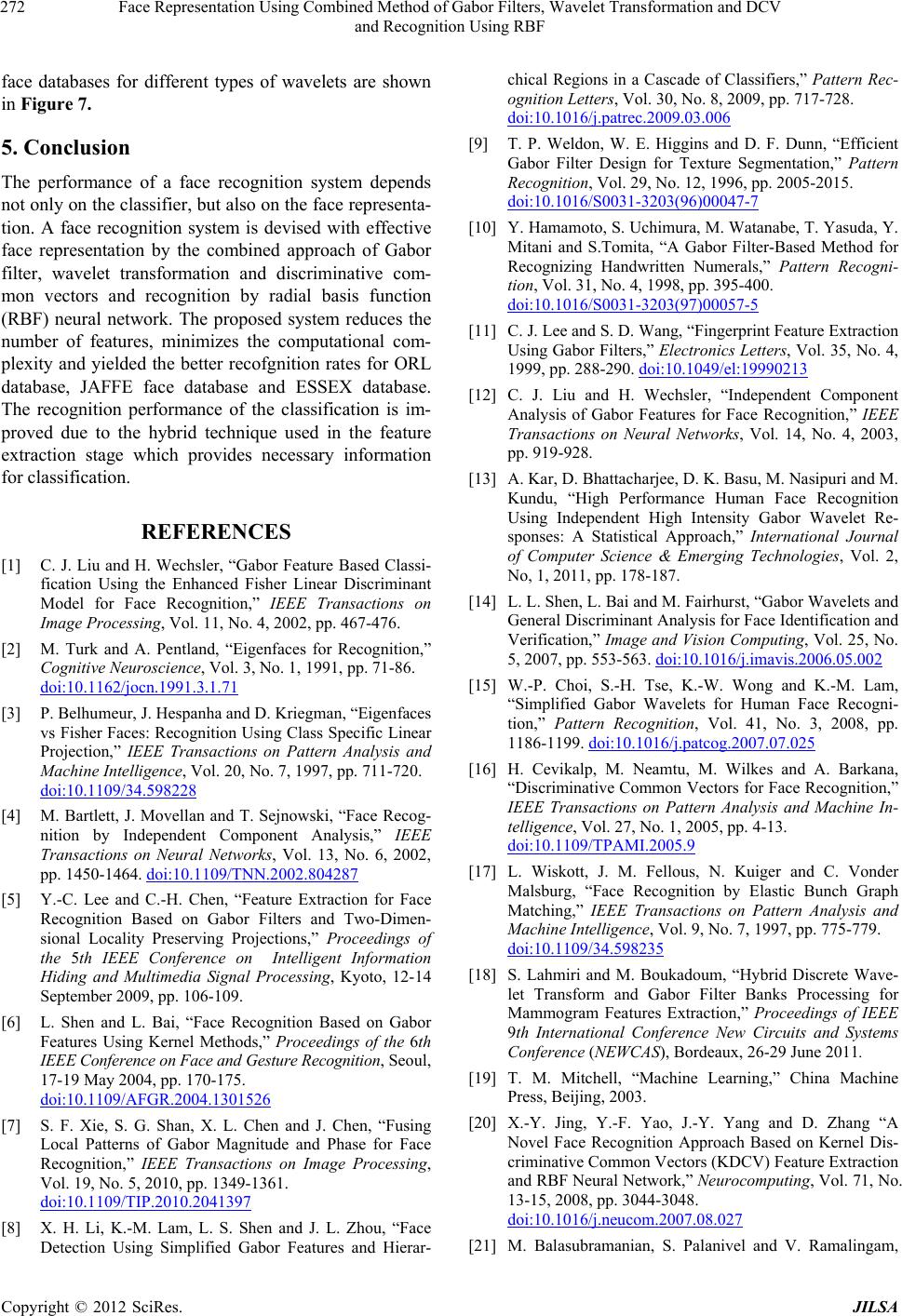
Face Representation Using Combined Method of Gabor Filters, Wavelet Transformation and DCV
and Recognition Using RBF
272
face databases for different types of wavelets are shown
in Figure 7.
5. Conclusion
The performance of a face recognition system depends
not only on the classifier, but also on the face representa-
tion. A face recognition system is devised with effective
face representation by the combined approach of Gabor
filter, wavelet transformation and discriminative com-
mon vectors and recognition by radial basis function
(RBF) neural network. The proposed system reduces the
number of features, minimizes the computational com-
plexity and yielded the better recofgnition rates for ORL
database, JAFFE face database and ESSEX database.
The recognition performance of the classification is im-
proved due to the hybrid technique used in the feature
extraction stage which provides necessary information
for classification.
REFERENCES
[1] C. J. Liu and H. Wechsler, “Gabor Feature Based Classi-
fication Using the Enhanced Fisher Linear Discriminant
Model for Face Recognition,” IEEE Transactions on
Image Processing, Vol. 11, No. 4, 2002, pp. 467-476.
[2] M. Turk and A. Pentland, “Eigenfaces for Recognition,”
Cognitive Neuroscience, Vol. 3, No. 1, 1991, pp. 71-86.
doi:10.1162/jocn.1991.3.1.71
[3] P. Belhumeur, J. Hespanha and D. Kriegman, “Eigenfaces
vs Fisher Faces: Recognition Using Class Specific Linear
Projection,” IEEE Transactions on Pattern Analysis and
Machine Intelligence, Vol. 20, No. 7, 1997, pp. 711-720.
doi:10.1109/34.598228
[4] M. Bartlett, J. Movellan and T. Sejnowski, “Face Recog-
nition by Independent Component Analysis,” IEEE
Transactions on Neural Networks, Vol. 13, No. 6, 2002,
pp. 1450-1464. doi:10.1109/TNN.2002.804287
[5] Y.-C. Lee and C.-H. Chen, “Feature Extraction for Face
Recognition Based on Gabor Filters and Two-Dimen-
sional Locality Preserving Projections,” Proceedings of
the 5th IEEE Conference on Intelligent Information
Hiding and Multimedia Signal Processing, Kyoto, 12-14
September 2009, pp. 106-109.
[6] L. Shen and L. Bai, “Face Recognition Based on Gabor
Features Using Kernel Methods,” Proceedings of the 6th
IEEE Conference on Face and Gesture Recognition, Seoul,
17-19 May 2004, pp. 170-175.
doi:10.1109/AFGR.2004.1301526
[7] S. F. Xie, S. G. Shan, X. L. Chen and J. Chen, “Fusing
Local Patterns of Gabor Magnitude and Phase for Face
Recognition,” IEEE Transactions on Image Processing,
Vol. 19, No. 5, 2010, pp. 1349-1361.
doi:10.1109/TIP.2010.2041397
[8] X. H. Li, K.-M. Lam, L. S. Shen and J. L. Zhou, “Face
Detection Using Simplified Gabor Features and Hierar-
chical Regions in a Cascade of Classifiers,” Pattern Rec-
ognition Letters, Vol. 30, No. 8, 2009, pp. 717-728.
doi:10.1016/j.patrec.2009.03.006
[9] T. P. Weldon, W. E. Higgins and D. F. Dunn, “Efficient
Gabor Filter Design for Texture Segmentation,” Pattern
Recognition, Vol. 29, No. 12, 1996, pp. 2005-2015.
doi:10.1016/S0031-3203(96)00047-7
[10] Y. Hamamoto, S. Uchimura, M. Watanabe, T. Yasuda, Y.
Mitani and S.Tomita, “A Gabor Filter-Based Method for
Recognizing Handwritten Numerals,” Pattern Recogni-
tion, Vol. 31, No. 4, 1998, pp. 395-400.
doi:10.1016/S0031-3203(97)00057-5
[11] C. J. Lee and S. D. Wang, “Fingerprint Feature Extraction
Using Gabor Filters,” Electronics Letters, Vol. 35, No. 4,
1999, pp. 288-290. doi:10.1049/el:19990213
[12] C. J. Liu and H. Wechsler, “Independent Component
Analysis of Gabor Features for Face Recognition,” IEEE
Transactions on Neural Networks, Vol. 14, No. 4, 2003,
pp. 919-928.
[13] A. Kar, D. Bhattacharjee, D. K. Basu, M. Nasipuri and M.
Kundu, “High Performance Human Face Recognition
Using Independent High Intensity Gabor Wavelet Re-
sponses: A Statistical Approach,” International Journal
of Computer Science & Emerging Technologies, Vol. 2,
No, 1, 2011, pp. 178-187.
[14] L. L. Shen, L. Bai and M. Fairhurst, “Gabor Wavelets and
General Discriminant Analysis for Face Identification and
Verification,” Image and Vision Computing, Vol. 25, No.
5, 2007, pp. 553-563. doi:10.1016/j.imavis.2006.05.002
[15] W.-P. Choi, S.-H. Tse, K.-W. Wong and K.-M. Lam,
“Simplified Gabor Wavelets for Human Face Recogni-
tion,” Pattern Recognition, Vol. 41, No. 3, 2008, pp.
1186-1199. doi:10.1016/j.patcog.2007.07.025
[16] H. Cevikalp, M. Neamtu, M. Wilkes and A. Barkana,
“Discriminative Common Vectors for Face Recognition,”
IEEE Transactions on Pattern Analysis and Machine In-
telligence, Vol. 27, No. 1, 2005, pp. 4-13.
doi:10.1109/TPAMI.2005.9
[17] L. Wiskott, J. M. Fellous, N. Kuiger and C. Vonder
Malsburg, “Face Recognition by Elastic Bunch Graph
Matching,” IEEE Transactions on Pattern Analysis and
Machine Intelligence, Vol. 9, No. 7, 1997, pp. 775-779.
doi:10.1109/34.598235
[18] S. Lahmiri and M. Boukadoum, “Hybrid Discrete Wave-
let Transform and Gabor Filter Banks Processing for
Mammogram Features Extraction,” Proceedings of IEEE
9th International Conference New Circuits and Systems
Conference (NEWCAS), Bordeaux, 26-29 June 2011.
[19] T. M. Mitchell, “Machine Learning,” China Machine
Press, Beijing, 2003.
[20] X.-Y. Jing, Y.-F. Yao, J.-Y. Yang and D. Zhang “A
Novel Face Recognition Approach Based on Kernel Dis-
criminative Common Vectors (KDCV) Feature Extraction
and RBF Neural Network,” Neurocomputing, Vol. 71, No.
13-15, 2008, pp. 3044-3048.
doi:10.1016/j.neucom.2007.08.027
[21] M. Balasubramanian, S. Palanivel and V. Ramalingam,
Copyright © 2012 SciRes. JILSA